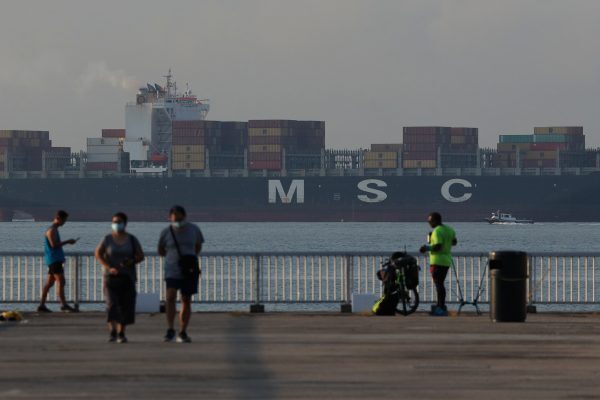Using blockchain to secure Asian supply chains

International supply chains are lengthy, complex and face risks of disruption. There is also public pressure on firms and governments to ensure supply chains adhere to social and environmental standards. While supply chain resilience can be achieved by developing transparency and traceability capacity, establishing end-to-end (E2E) supply chain visibility is the holy grail of supply chain management — and it can be achieved through blockchain technology.
![]()
Cross-border supply chains are often ladened with paper documents. Although bills of lading are one of the most important documents issued from carriers to shippers, only 0.1 per cent of original bills are digitised. The handling and exchange of such paper documents is costly, error prone and time consuming. Supply chain finance transactions share the same problem and typically involve a complicated paper trail that can take as long as a month to be completed.
Distributed ledger technologies (DLTs) — or blockchain technology — could address these legacy problems. DLT is a shared, distributed electronic ledger that can record transactions as they occur between parties in a tamper-resistant manner. Based on the access control and centralisation, blockchains can be categorised into three categories – public blockchain that allows anyone to participate in the network and consensus process, private or permissioned blockchain that allows a selected group with existing trust or business relationship to participate and hybrid blockchain which is a mixture of both. For supply chains, private or permissioned blockchains are generally used.
The dispersion of trust away from a centralised authority or dominant player to a decentralised peer-to-peer based architecture replaces traditional server–client data management and trusted third parties upon which supply chains traditionally depend. Peer-to-peer systems also safeguard against any form of asymmetric coercion or unethical practice within the consortium.
The deployment of blockchain technology to address frictions in cross-border trade finance and increase supply chain efficiency has recently gathered momentum. BHP Group and China Baowu completed their first iron ore trade on MineHub’s blockchain-based platform in April 2020. The transaction’s value was approximately 1 billion RMB (US$156 million).
BHP also piloted the use of blockchain to trace copper concentrate shipments with China Minmetals Non-Ferrous Metals in the second half of 2021. TradeLens, a supply chain platform powered by blockchain technology, saved 10 days of document processing time by enabling a paperless shipment of Agrichemical products from South Korea to Bangladesh.
Exploitation of labour is another important but often overlooked cross-border supply chain issue. This is largely due to a lack of supply chain transparency, shirking of corporate, social and governance responsibility and poor government regulations.
Asia Pacific fishing industries, for example, supply 60 per cent of the world’s tuna catch worth over US$22 billion. Yet the industry is so rife with modern slavery that the Australian parliament passed the Modern Slavery Act in 2018. Modern slavery is also rampant in the shrimp supply chain, where 90 per cent of migrant workers are vulnerable to being trafficked or ‘sold to the sea’. In 2015, the European Union imposed a ‘yellow card’ on Thailand to sanction its illegal, unreported and unregulated (IUU) fishing framework.
Modern slavery issues in global supply chains have been addressed using different blockchain-based solutions. London-based NGO Provenance works with stakeholders— from Indonesian tuna fishermen to the restaurants in London — across the tuna supply chain. But its aim to capture labour related information (identity, wages and employment contracts) in conjunction with product-related information faces several challenges.
First, it is difficult to find information in an environment where IUU activities are rampant, impetus for regulations is weak and labour contracts are either verbal or clandestine. Second, it remains difficult to integrate legacy data management and IT systems with different Internet of Things (IoT) devices. The third challenge is that, once integrated, investigators need to establish data interoperability to analyse information gleaned from legacy systems and devices.
The growing availability of wearable devices and digitisation of national identity will make it easier to identify labour inputs in supply chains. Clandestine contracts can now be coded into smart contracts — contracts written in computer code that execute transactions through blockchain — and connected with payroll systems.
The World Food Building Blocks program enables refugees to receive assistance using their biometric signature. This blockchain based humanitarian solution addresses concerns about IUU because invoices from suppliers are cleared when time stamped biometric signatures from all labour sources are appropriately recorded on the blockchain.
Despite these advances, blockchain should not be treated as a silver bullet. A systematic approach is needed to address social and economic challenges, including through changes to business processes and stakeholder collaboration coupled with legal, policy and technological interventions.
Data security, privacy and integrity, as well as interoperability, are technical areas of concern. These integration and interoperability issues can be addressed by implementing blockchain-based solutions as a separate layer, which can be integrated with existing legacy systems through an application programming interface.
Enabled by blockchain technology, the information, cash and material flows for cross-border supply chains can be streamlined. Exemplar blockchain-based projects show that this technology provides much needed transparency, traceability and trust for all supply chain stakeholders. This helps organisations cope with increasing disruptions by establishing resilient and agile supply chain practices that are purpose-driven.
This article was written by Yingli Wang, a Professor in logistics and operations management at Cardiff University; and Imtiaz Khan, an Associate Professor of Data Science at Cardiff Metropolitan University. It was published by the East Asia Forum.
Yingli Wang is a Professor at Cardiff University in logistics and operations management. Over the last decade, she has worked intensively with many organizations including shippers, logistics service providers and IT service providers in the field of e-logistics











